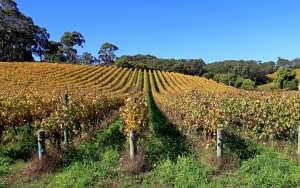"The usual way to control a major pest invasion in an orchard or vineyard is to dig up all the trees or vines and burn them," explains the Chief Executive Officer of the CRC for National Plant Biosecurity (CRCNPB), Dr Simon McKirdy.
"This can cause heartbreak, destroy livelihoods and disrupt a whole industry. In the case of vines that may be 100 years old, the loss is irreplaceable. We decided there had to be a better way."
A team of CRCNPB researchers led by Dr Mark Sosnowski of the South Australian Research & Development Institute (SARDI) has joined hands with their American plant biosecurity colleagues to run an offshore trial in which they have proved it is possible to exterminate a dangerous crop disease – without destroying the farm.
Their chosen target was a fungal disease not yet found in Australia, known as black rot – a devastating disease of vines.
"Our approach was to try out various disease control strategies in the field, under real life conditions," Dr Sosnowski explains "as black rot does not occur in Australia, we had to do the final tests with the live disease in the US, where it is endemic."
The researchers started their trials in Australia using a local fungal disease called black spot that behaves similarly to black rot. In the first year they cut the infected vines right back to the trunk and sprayed them, while litter on the ground was cleared and burned. This achieved 90 per cent control of the disease.
"But 90 per cent isn’t good enough," Dr Sosnowski says. "If you’re trying to eradicate a new invader, you need 100 per cent control. So we added in some further steps."
These included mulching to stop any fungus lurking in the soil from moving up into the vines, pruning low shoots that are vulnerable to infection and applying a foliar fungicide to the new leaves.
Satisfied that the new tactics worked for black spot, they then partnered with Cornell University in the US which has a major research program aimed at controlling black rot, a disease costing American grape growers millions of dollars every year.
Over two years of trials the Australian and American scientists achieved total control of black rot in the field using the Australian approach – not a single symptom was found on any of the treated vines, whereas untreated vines were heavily infested with disease.
"This was a terrific result, as it demonstrated not only could we potentially control a black rot outbreak, should one ever occur in Australia – but it has also opened up scope to prevent other plant diseases affecting vines or tree crops," says Dr Simon McKirdy. "It is a great improvement on having to rip out and burn every infected tree or vine."
So far the team has identified at least 25 major crop diseases which appear susceptible to the new control method. These affect crops ranging from citrus, apples, grapevines and bananas to mangos, avocados, pecans, chestnuts, hazelnuts and even eucalypts and pine trees.
"For example we’re fairly confident it can be used to control black sigatoka, an extremely serious fungal disease of bananas in other parts of the world, based on what we know from an outbreak in Queensland a few years ago," Dr Sosnowski adds.
Dr McKirdy says it is quite likely the Australian eradication method will also be taken up and used by other countries to improve crop health. "And that is a biosecurity plus for Australia, as better disease control overseas will reduce the likelihood of diseases entering this country." However, he adds, the main beneficiaries are the horticulturalists who won’t have to watch their life’s work go up in smoke should certain new fungal pests find their way into Australia.
"We’re detecting between two and three dozen new pests and diseases in Australia every year – so the need for better ways to spot, contain and eradicate them is never ending," he adds.






